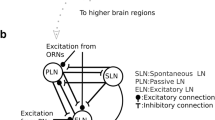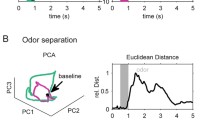Abstract
Kenyon cells, the intrinsic neurons of the insect mushroom body, have the intriguing property of responding in a sparse way to odorants. Sparse neuronal codes are often invariant to changes in stimulus intensity and duration, and sparse coding often depends on global inhibition. We tested if this is the case for honeybees’ Kenyon cells, too, and used in vivo Ca2+ imaging to record their responses to different odorant concentrations. Kenyon cells responded not only to the onset of odorant stimuli (ON responses), but also to their termination (OFF responses). Both, ON and OFF responses increased with increasing odorant concentration. ON responses were phasic and invariant to the duration of odorant stimuli, while OFF responses increased with increasing odorant duration. Pharmacological blocking of GABA receptors in the brain revealed that ionotropic GABAA and metabotropic GABAB receptors attenuate Kenyon cells’ ON responses without changing their OFF responses. Ionotropic GABAA receptors attenuated Kenyon cell ON responses more strongly than metabotropic GABAB receptors. However, the response dynamic, temporal resolution and paired-pulse depression did not depend on GABAA transmission. These data are discussed in the context of mechanisms leading to sparse coding in Kenyon cells.





Similar content being viewed by others
Abbreviations
- GABA:
-
γ-Aminobutyric acid
- cKC:
-
Clawed Kenyon cell
- MB:
-
Mushroom body
- PCT:
-
Protocerebral-calycal tract
- BMI:
-
Bicuculline methiodide
- PTX:
-
Picrotoxin
- CGP:
-
CGP54626
- ROI:
-
Region of interest
References
Abel R, Rybak J, Menzel R (2001) Structure and response patterns of olfactory interneurons in the honeybee, Apis mellifera. J Comp Neurol 437:363–383
Asay MJ, Boyd SK (2006) Characterization of the binding of [3H]CGP54626 to GABAB receptors in the male bullfrog (Rana catesbeiana). Brain Res 1094:76–85
Assisi C, Stopfer M, Laurent G, Bazhenov M (2007) Adaptive regulation of sparseness by feedforward inhibition. Nat Neurosci 10:1176–1184
Barbara GS, Zube C, Rybak J, Gauthier M, Grünewald B (2005) Acetylcholine, GABA and glutamate induce ionic currents in cultured antennal lobe neurons of the honeybee, Apis mellifera. J Comp Physiol A 191:823–836
Bicker G (1999) Histochemistry of classical neurotransmitters in antennal lobes and mushroom bodies of the honeybee. Microsc Res Techniq 45:174–183
Bicker G, Schäfer S, Kingan TG (1985) Mushroom body feedback interneurones in the honeybee show GABA-like immunoreactivity. Brain Res 360:394–397
Chou YH, Spletter ML, Yaksi E, Leong JC, Wilson RI, Luo L (2010) Diversity and wiring variability of olfactory local interneurons in the Drosophila antennal lobe. Nat Neurosci 13:439–449
Choudhary AF, Laycock I, Wright GA (2012) gamma-Aminobutyric acid receptor A-mediated inhibition in the honeybee’s antennal lobe is necessary for the formation of configural olfactory percepts. Eur J Neurosci 35:1718–1724
Davis RL (1993) Mushroom bodies and Drosophila learning. Neuron 11:1–14
Deglise P, Grünewald B, Gauthier M (2002) The insecticide imidacloprid is a partial agonist of the nicotinic receptor of honeybee Kenyon cells. Neurosci Let 321:13–16
Demmer H, Kloppenburg P (2009) Intrinsic membrane properties and inhibitory synaptic input of Kenyon cells as mechanisms for sparse coding? J Neurophysiol 102:1538–1550
El Hassani AK, Giurfa M, Gauthier M, Armengaud C (2008) Inhibitory neurotransmission and olfactory memory in honeybees. Neurobiol Learn Mem 90:589–595
Enell L, Hamasaka Y, Kolodziejczyk A, Nässel DR (2007) gamma-Aminobutyric acid (GABA) signaling components in Drosophila: immunocytochemical localization of GABA(B) receptors in relation to the GABA(A) receptor subunit RDL and a vesicular GABA transporter. J Comp Neurol 505:18–31
Farkhooi F, Froese A, Muller E, Menzel R, Nawrot MP (2013) Cellular adaptation facilitates sparse and reliable coding in sensory pathways. PLoS Comput Biol 9(10):e1003251
Fonta C, Sun XJ, Masson C (1993) Morphology and spatial-distribution of bee antennal lobe interneurons responsive to odors. Chem Sens 18:101–119
Galizia CG, Kimmerle B (2004) Physiological and morphological characterization of honeybee olfactory neurons combining electrophysiology, calcium imaging and confocal microscopy. J Comp Physiol A 190:21–38
Galizia CG, Joerges J, Kuttner A, Faber T, Menzel R (1997) A semi-in vivo preparation for optical recording of the insect brain. J Neurosci Method 76:61–69
Ganeshina O, Menzel R (2001) GABA-immunoreactive neurons in the mushroom bodies of the honeybee: an electron microscopic study. J Comp Neurol 437:335–349
Grünewald B (1999a) Morphology of feedback neurons in the mushroom body of the honeybee, Apis mellifera. J Comp Neurol 404:114–126
Grünewald B (1999b) Physiological properties and response modulations of mushroom body feedback neurons during olfactory learning in the honeybee Apis mellifera. J Comp Physiol A 185(6):565–576
Grünewald B, Wersing A (2008) An ionotropic GABA receptor in cultured mushroom body Kenyon cells of the honeybee and its modulation by intracellular calcium. J Comp Physiol A 194:329–340
Haehnel M, Menzel R (2010) Sensory representation and learning-related plasticity in mushroom body extrinsic feedback neurons of the protocerebral tract. Front Syst Neurosci 4:161
Haehnel M, Menzel R (2012) Long-term memory and response generalization in mushroom body extrinsic neurons in the honeybee Apis mellifera. J Exp Biol 215:559–565
Heisenberg M (2003) Mushroom body memoir: from maps to models. Nat Rev Neurosci 4:266–275
Honegger KS, Campbell RAA, Turner GC (2011) Cellular-resolution population imaging reveals robust sparse coding in the Drosophila mushroom body. J Neurosci 31:11772–11785
Huang J, Zhang W, Qiao W, Hu A, Wang Z (2010) Functional connectivity and selective odor responses of excitatory local interneurons in Drosophila antennal lobe. Neuron 67:1021–1033
Ito I, Ong RCY, Raman B, Stopfer M (2008) Sparse odor representation and olfactory learning. Nat Neurosci 11:1177–1184
Jortner RA, Farivar SS, Laurent G (2007) A simple connectivity scheme for sparse coding in an olfactory system. J Neurosci 27:1659–1669
Krofczik S, Menzel R, Nawrot MP (2009) Rapid odor processing in the honeybee antennal lobe network. Front Comput Neurosc 2:9
Laurent G (2002) Olfactory network dynamics and the coding of multidimensional signals. Nat Rev Neurosci 3:884–895
Laurent G, Stopfer M, Friedrich RW, Rabinovich MI, Volkovskii A, Abarbanel HDI (2001) Odor encoding as an active, dynamical process: experiments, computation, and theory. Annu Rev Neurosci 24:263–297
Lei H, Riffell JA, Gage SL, Hildebrand JG (2009) Contrast enhancement of stimulus intermittency in a primary olfactory network and its behavioral significance. J Biol 8:21
Lei Z, Chen K, Li H, Liu H, Guo A (2013) The GABA system regulates the sparse coding of odors in the mushroom bodies of Drosophila. Biochem Biophys Res Comm 436:35–40
Leitch B, Laurent G (1996) GABAergic synapses in the antennal lobe and mushroom body of the locust olfactory system. J Comp Neurol 372:487–514
Menzel R (2012) The honeybee as a model for understanding the basis of cognition. Nat Rev Neurosci 13:758–768
Mobbs PG (1982) The brain of the honeybee Apis mellifera.1. The connections and spatial-organization of the mushroom bodies. Philos T Roy Soc B 298:309–354
Müller D, Abel R, Brandt R, Zockler M, Menzel R (2002) Differential parallel processing of olfactory information in the honeybee, Apis mellifera L. J Comp Physiol A 188:359–370
Murthy M, Fiete I, Laurent G (2008) Testing odor response stereotypy in the Drosophila mushroom body. Neuron 59:1009–1023
Olsen SR, Wilson RI (2008) Lateral presynaptic inhibition mediates gain control in an olfactory circuit. Nature 452:956–960
Papadopoulou M, Cassenaer S, Nowotny T, Laurent G (2011) Normalization for sparse encoding of odors by a wide-field interneuron. Science 332:721–725
Pelz C, Gerber B, Menzel R (1997) Odorant intensity as a determinant for olfactory conditioning in honeybees: roles in discrimination, overshadowing and memory consolidation. J Exp Biol 200:837–847
Perez-Orive J, Mazor O, Turner GC, Cassenaer S, Wilson RI, Laurent G (2002) Oscillations and sparsening of odor representations in the mushroom body. Science 297:359–365
Perez-Orive J, Bazhenov M, Laurent G (2004) Intrinsic and circuit properties favor coincidence detection for decoding oscillatory input. J Neurosci 24:6037–6047
Root CM, Masuyama K, Green DS, Enell LE, Nassel DR, Lee CH, Wang JW (2008) A presynaptic gain control mechanism fine-tunes olfactory behavior. Neuron 59:311–321
Rotte C, Witte J, Blenau W, Baumann O, Walz B (2009) Source, topography and excitatory effects of GABAergic innervation in cockroach salivary glands. J Exp Biol 212:126–136
Rybak J, Menzel R (1993) Anatomy of the mushroom bodies in the honey-bee brain: the neuronal connections of the alpha-lobe. J Comp Neurol 334:444–465
Sachse S, Galizia CG (2002) Role of inhibition for temporal and spatial odor representation in olfactory output neurons: a calcium imaging study. J Neurophysiol 87:1106–1117
Sachse S, Galizia CG (2003) The coding of odour-intensity in the honeybee antennal lobe: local computation optimizes odour representation. Eur J Neurosci 18:2119–2132
Sachse S, Peele P, Silbering AF, Gühmann M, Galizia CG (2006) Role of histamine as a putative inhibitory transmitter in the honeybee antennal lobe. Front Zool 3:22
Schäfer S, Bicker G (1986) Distribution of GABA-like immunoreactivity in the brain of the honeybee. J Comp Neurol 246:287–300
Schäfer S, Rosenboom H, Menzel R (1994) Ionic currents of Kenyon cells from the mushroom body of the honeybee. J Neurosci 14:4600–4612
Seki Y, Rybak J, Wicher D, Sachse S, Hansson BS (2010) Physiological and morphological characterization of local interneurons in the Drosophila antennal lobe. J Neurophysiol 104:1007–1019
Silbering AF, Galizia CG (2007) Processing of odor mixtures in the Drosophila antennal lobe reveals both global inhibition and glomerulus-specific interactions. J Neurosci 27:11966–11977
Stopfer M (2005) Olfactory coding: inhibition reshapes odor responses. Curr Biol 15:R996–R998
Stopfer M, Bhagavan S, Smith BH, Laurent G (1997) Impaired odour discrimination on desynchronization of odour-encoding neural assemblies. Nature 390:70–74
Stopfer M, Jayaraman V, Laurent G (2003) Intensity versus identity coding in an olfactory system. Neuron 39:991–1004
Strauch M, Ditzen M, Galizia CG (2012) Keeping their distance? Odor response patterns along the concentration range. Front Syst Neurosci 6:71
Strausfeld NJ (2002) Organization of the honey bee mushroom body: representation of the calyx within the vertical and gamma lobes. J Comp Neurol 450:4–33
Sun XJ, Fonta C, Masson C (1993) Odor quality processing by bee antennal lobe interneurons. Chem Sens 18:355–377
Szyszka P, Ditzen M, Galkin A, Galizia CG, Menzel R (2005) Sparsening and temporal sharpening of olfactory representations in the honeybee mushroom bodies. J Neurophysiol 94:3303–3313
Szyszka P, Galkin A, Menzel R (2008) Associative and non-associative plasticity in Kenyon cells of the honeybee mushroom body. Front Syst Neurosci 2:3
Turner GC, Bazhenov M, Laurent G (2008) Olfactory representations by Drosophila mushroom body neurons. J Neurophysiol 99:734–746
Wang Y, Guo HF, Pologruto TA, Hannan F, Hakker I, Svoboda K, Zhong Y (2004) Stereotyped odor-evoked activity in the mushroom body of Drosophila revealed by green fluorescent protein-based Ca2 + imaging. J Neurosci 24:6507–6514
Wilson RI, Laurent G (2005) Role of GABAergic inhibition in shaping odor-evoked spatiotemporal patterns in the Drosophila antennal lobe. J Neurosci 25:9069–9079
Wright GA, Carlton M, Smith BH (2009) A honeybee’s ability to learn, recognize, and discriminate odors depends upon odor sampling time and concentration. Behav Neurosci 123:36–43
Yamagata N, Schmuker M, Szyszka P, Mizunami M, Menzel R (2009) Differential odor processing in two olfactory pathways in the honeybee. Front Syst Neurosci 3:16
Yarali A, Ehser S, Hapil FZ, Huang J, Gerber B (2009) Odour intensity learning in fruit flies. P Roy Soc B 276:3413–3420
Acknowledgments
We are grateful to Drs. Silke Sachse, Melanie Haehnel and Nobuhiro Yamagata for their help and advice during the experiments. The work was supported by a grant of the Deutsche Forschungsgemeinschaft (Me 365/31-1).
Author information
Authors and Affiliations
Corresponding author
Rights and permissions
About this article
Cite this article
Froese, A., Szyszka, P. & Menzel, R. Effect of GABAergic inhibition on odorant concentration coding in mushroom body intrinsic neurons of the honeybee. J Comp Physiol A 200, 183–195 (2014). https://doi.org/10.1007/s00359-013-0877-8
Received:
Revised:
Accepted:
Published:
Issue Date:
DOI: https://doi.org/10.1007/s00359-013-0877-8




